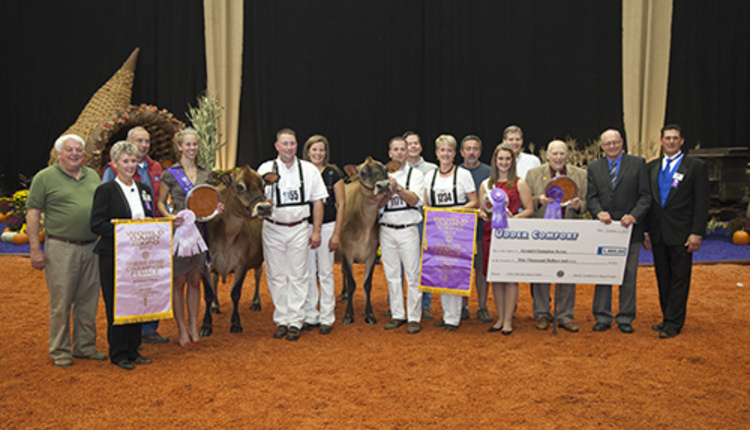You may be facing challenges with the availability and expense of common bedding sources such as sawdust or the management of sand bedding. In recent years recycled manure solids have become a more prevalent bedding source on dairy farms. With the growing demand for producers to seek more sustainable practices, it seems like bedding with recycled manure solids could be a win-win situation.
If only it could be that easy. Although sustainability, availability and cost are major factors when selecting bedding sources, cow comfort and cleanliness should receive equal if not more consideration. Likewise, some producers are hesitant to use recycled manure solids until they see evidence that this option is working for other herds.
Marcia Endres and Adam Husfeldt of the University of Minnesota recently conducted a study to help skeptical producers and professionals weigh the pros and cons of this bedding option. Endres presented their findings at the Four State Dairy Nutrition and Management Conference on June 13.
They conducted an observational study involving 38 dairy farms in Wisconsin, Minnesota, South Dakota and Iowa that were using recycled manure solids for bedding free stalls. They aimed to find out if recycled manure solids influence SCC and animal welfare.
The study observed herds that used recycled manure solids in deep-bedded free stalls as well as herds that used it on top of mattresses. They found that herds with deep beds had a lower prevalence of lameness and hock lesions compared to herds with mattresses. After comparing these observations to studies with sand bedding, they learned that lameness prevalence was similar, hock lesion prevalence was slightly higher and cow hygiene was better in herds using recycled manure solids.
"One of the major concerns expressed by producers considering the use of manure solids for bedding is the possibility of increased somatic cell count," explained Endres. "But the cows in this study were on average cleaner than any other free stall study we have conducted."
She also noted that she preferred the odor of manure solids compared to sand. However, Endres noted that they recorded relatively high numbers for clinical mastitis. Therefore, like any other bedding source, you must pay close attention to detect clinical cases. Overall, they concluded that excellent cow preparation at milking time, sanitation of milking equipment, cow hygiene, adequate dry cow housing and bedding/stall management are critical to maintaining a low somatic cell count when using manure solids for bedding.
So, rather than asking if recycled manure solids are a quality bedding option, the question should be, are you willing to take the management steps necessary to successfully bed with recycled manure solids?
To view a more in depth analysis of the findings from the study, click here.
If only it could be that easy. Although sustainability, availability and cost are major factors when selecting bedding sources, cow comfort and cleanliness should receive equal if not more consideration. Likewise, some producers are hesitant to use recycled manure solids until they see evidence that this option is working for other herds.
Marcia Endres and Adam Husfeldt of the University of Minnesota recently conducted a study to help skeptical producers and professionals weigh the pros and cons of this bedding option. Endres presented their findings at the Four State Dairy Nutrition and Management Conference on June 13.
They conducted an observational study involving 38 dairy farms in Wisconsin, Minnesota, South Dakota and Iowa that were using recycled manure solids for bedding free stalls. They aimed to find out if recycled manure solids influence SCC and animal welfare.
The study observed herds that used recycled manure solids in deep-bedded free stalls as well as herds that used it on top of mattresses. They found that herds with deep beds had a lower prevalence of lameness and hock lesions compared to herds with mattresses. After comparing these observations to studies with sand bedding, they learned that lameness prevalence was similar, hock lesion prevalence was slightly higher and cow hygiene was better in herds using recycled manure solids.
"One of the major concerns expressed by producers considering the use of manure solids for bedding is the possibility of increased somatic cell count," explained Endres. "But the cows in this study were on average cleaner than any other free stall study we have conducted."
She also noted that she preferred the odor of manure solids compared to sand. However, Endres noted that they recorded relatively high numbers for clinical mastitis. Therefore, like any other bedding source, you must pay close attention to detect clinical cases. Overall, they concluded that excellent cow preparation at milking time, sanitation of milking equipment, cow hygiene, adequate dry cow housing and bedding/stall management are critical to maintaining a low somatic cell count when using manure solids for bedding.
So, rather than asking if recycled manure solids are a quality bedding option, the question should be, are you willing to take the management steps necessary to successfully bed with recycled manure solids?
To view a more in depth analysis of the findings from the study, click here.








